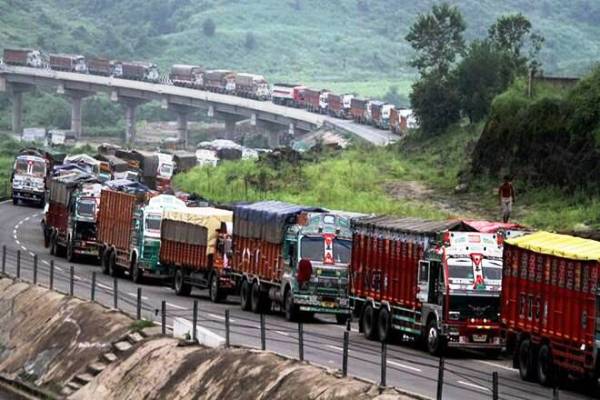A Valley Isolated
By: Javid Amin | 04 Sep 2025
For the second time in less than a decade, Kashmir has been completely cut off from mainland India. Relentless rains have battered the Himalayas, triggering landslides, flash floods, and road collapses across Jammu and Kashmir, leaving the Valley stranded.
Surface links have been snapped, rail corridors suspended, and air traffic disrupted. Over 3,500 vehicles are stranded across Kathua, Ramban, and Qazigund, while essential supplies — fuel, medicines, and vegetables — are running thin.
For residents, déjà vu is setting in. Each monsoon, the question resurfaces: Can Kashmir afford to remain this fragile?
Roads Buried, Highways Broken
Jammu–Srinagar National Highway (NH-44): The Lifeline Severed
The NH-44, Kashmir’s only all-weather road to the rest of India, lies buried under multiple landslides in the Ramban–Banihal sector. At least three major sinking patches have made stretches impassable, with no immediate restoration in sight. For now, trucks carrying essentials wait endlessly on either side, while stranded families sleep in their vehicles.
Alternate Roads: All Blocked
-
Mughal Road — connecting Shopian to Rajouri and Poonch — is buried under mudslides and shooting stones.
-
Zojila Pass — the gateway to Ladakh — is closed due to incessant rockfalls.
-
Sinthan Top — a critical link to Kishtwar — is also shut.
This simultaneous closure of alternate routes highlights the absence of redundant connectivity in the Himalayan state. When NH-44 goes down, the entire Valley is stranded.
Rail Traffic Suspended
Rail was once touted as Kashmir’s alternate lifeline. But the Pathankot–Jammu section has suffered track breaches, ballast washouts, and misalignments, suspending services for over nine days.
The dream of uninterrupted Baramulla–Banihal–Jammu rail connectivity remains half-fulfilled. As a result, Kashmir still has no reliable rail corridor for emergencies.
Schools Shut, Lives Disrupted
With roads unsafe and water levels rising, schools, colleges, and universities have been ordered shut across both Jammu and Kashmir divisions. Examinations have been postponed, forcing thousands of students into uncertainty.
Businesses face daily losses. Farmers fear perishables rotting before they can reach mandis. Patients with chronic conditions worry about medicine shortages.
Connectivity collapse is not just an infrastructure crisis — it is a humanitarian one.
A Wider Himalayan Emergency
This is not an isolated Kashmir story. Across North India, the monsoon is rewriting the map of vulnerability:
-
Himachal Pradesh: 343 deaths, over 1,292 roads cut off, ₹3,690 crore in damages.
-
Punjab: Worst flood in 30 years, 3.55 lakh people affected.
-
Delhi: Yamuna above danger mark, low-lying neighbourhoods inundated.
The Himalayas are bearing the brunt of climate-amplified rainfall — intense downpours, landslides, and collapsing slopes. Kashmir is simply the latest epicentre.
Why This Keeps Happening
Experts say the reasons are as much political as natural:
-
Overreliance on NH-44: A single, fragile highway carries 90% of Valley supplies. Any closure paralyzes the region.
-
Unscientific road widening: Continuous blasting, hill cutting, and deforestation weaken slopes, making them prone to landslides.
-
Ignored warnings: Geologists have long recommended alternate corridors, slope stabilization, and tunnel expansion — but plans remain stuck.
-
Climate Change: Intense short-burst rains now overwhelm mountain drainage, eroding roads faster than they can be repaired.
The Way Forward: Building Climate-Resilient Corridors
If Kashmir is to avoid future isolation, the path ahead must be bold and science-driven:
-
Diversify Connectivity: Accelerate all-weather tunnels (Zojila, Mughal Road, Chenani–Nashri expansion).
-
Disaster-Proof Design: Use climate models to redesign slopes, drainage, and retaining walls.
-
Strengthen Rail Alternatives: Complete Baramulla–Banihal–Jammu line to ensure redundancy.
-
Early-Warning Systems: Install AI-driven landslide monitoring sensors across Ramban–Banihal.
-
Ecological Safeguards: Stop reckless hill-cutting, restore forests, and integrate green engineering into road building.
Connectivity in Kashmir should not collapse every time it rains.
Editorial Closing
Kashmir’s isolation this week is not just a weather story. It is a warning bell about policy failure, fragile infrastructure, and the perils of ignoring ecological science.
Each landslide and sinking patch on NH-44 is a reminder that the Valley cannot afford to gamble its future on fragile, reactive infrastructure.
The question policymakers must answer is simple: Do we wait for another disaster, or do we invest in resilience now?



